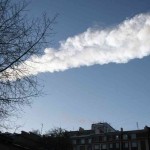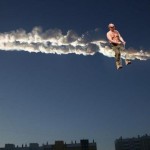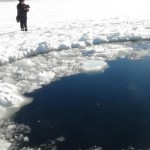Friday, February 15, 2013: A 50-foot wide meteor streaked across the skies in the Chelyabinsk region of the Russian Ural Mountains at day break this Friday morning, 9am Russian time. The meteor entered the earth’s atmosphere at 32,800 feet high (11,000 meters), traveling at the speed of 40,000 miles per hour, or 10-20 miles per second. The meteor streaked and whistled across the sky, with an awesomely large bright round light, brighter than the sun for its head, and a long white thick smokey tail, before crashing about 7 minutes later.
Fearful eyewitnesses never before experienced this. Was it a rocket crash, the power of 33 Hiroshima atomic bombs, a military attack, or the end of the world? Stopping to observe the phenomenon in amazement, many including school children, were drawn to the windows. As the meteorite crashed and ended its journey, it unexpectedly generated wind and a shock wave that shook buildings and broke windows in a radius for miles. The impact on windows rained glass on the bystanders, injuring over an estimated 1100 people, and resulting in 48 hospitalizations. People took cell phone photos and videos and posted images on internet immediately, including memes such as one photoshopped image of a bare-chested Putin riding the tail.
Also Friday, another coincidental but unrelated event was taking place: a 150-foot wide rock, an asteroid known as “2012 AD 14”, passed earth. This predicted event occurred within two hours of the unpredicted Russian meteorite crash. The asteroid passed quite close to earth just inside the outer ring of high-earth orbiting satellites. The trajectories, the travel paths, of the asteroid and the Russian meteorite originated from different directions, hence their earthly passing is a cosmically curious coincidence, yet like ships passing in the night, the two events are astronomically unrelated.
The people of Chelyabinsk had quite a scare initially before learning the cause of the event, and during the response to locate family members and tend to injuries. Schools and offices in Chelyabinsk closed for the day, and will likely close tomorrow, while the massive undertaking to cleanup and replace windows proceeds. With the windows open, the indoor spaces are exposed to the cold winter air.
According to NASA, this meteorite compared to the power of 33 Hiroshima atomic bombs, and was the largest hit since the Tunguska incident in Siberia in 1908 that scorched 825 square miles of forest.
https://www.youtube.com/watch?v=BEptPr0jVxw
Take away definitions:
- Asteroid – a mineral-rich rock, or mixture of rock and ice, in orbit around a star. Here, in orbit around our sun in our solar system.
- Comet – an object consisting of a central mass (asteroid) surrounded by dust and gas that may form a tail, orbiting a star, usually in an eccentric orbit.
- Meteoroid – small space debris, such as parts of asteroids or comets, on a collision course with earth.
- Meteor – a meteoroids that enters the earth’s atmosphere.Most meteors burn up in the atmosphere, sometimes causing a visual or streaking effect from the dust as it dissipates.
- Meteorite – a meteor that survives and strikes the surface of the earth.



